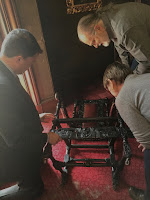Tucked into a corner of the dining room at the Gibson House sits a high-backed armchair. In 2018, long-time museum patron Robert Severy offered to fund a restoration of this chair, as the red upholstery had cracked and faded. But what, exactly, would we be restoring? To solve this object mystery, we needed the help of two esteemed curators, a fabric reproduction specialist, and a restoration studio.
Step 1: Research.
Per Charlie Gibson’s probate inventory (an accounting of possessions taken at the time of death), we know the chair was in the Gibson House in 1954. Museum records indicated our chair was an 1850s copy of an earlier style of chair; however, a note in the files suggested the chair was originally caned and therefore much older. Which story was correct? We needed more information.
Step 2: Call in the experts.
Two furniture curators, Thomas Michie (Museum of Fine Arts, Boston) and Brock Jobe (University of Delaware), were kind enough to come by and examine the chair from top rail to castors. Thanks to their expertise, we learned that our chair was an original William and Mary-era high-backed chair, of a type mass-produced in London in the late seventeenth century. It was originally caned. How did the chair make it to America? Not clear, but also not surprising, as these chairs were quite popular throughout the Atlantic World. It was evident that the chair had been re-made; the seat rails were trimmed to accommodate a slip seat, and the original feet were cut off and replaced with castors. The most exciting discovery was finding remnants of previous coverings, including eighteenth-century linen and Gothic-style oilcloth, underneath the late nineteenth-century red naugahyde upholstery.
Step 3: Restoration time.
 |
| Remnant and reproduction cloth. Photo: Marylou Davis |
Since our chair had gone through a few different looks over its history, we first needed to determine which period to restore it to. The seventeenth-century original caning didn’t necessarily make sense in the context of a nineteenth-century Victorian home. Maybe the Gothic oilcloth better connected the chair’s story to the Gibson story? We hired fabric restoration specialist Marylou Davis to reproduce an exact copy of the fragment of oilcloth. First, she developed a pattern by hand and created stencils. Then, she stretched and hand-colored the canvas cloth to match the original sample. Finally, she printed and varnished the cloth.
Next, we sent the reproduction oilcloth and the chair itself to the restoration studio at Trefler’s for re-upholstery. The furniture conservators also did some structural work around the joints and finials, although it was important to us that we preserve the black-paint layers and patina.
Step 4: Install and admire.
 |
| Evolution of chair. Photo: Kody Kirland (Trefler's) |
After almost a year of research and restoration, our chair returned to the dining room last spring. The gold accents in the reproduction fabric are a perfect complement to the rich red carpet. And the fleur-de-lis design echoes the etchwork in the glass doors leading into the dining room. We now know more about the path this chair took to reach us, and we are better able to tell its story and put it in the context of the Gibson family collection. Unraveling this mystery has made this piece one of my favorites.
- Meghan Gelardi Holmes, Curator
We are featuring some of our favorite objects over on Instagram. Come see!
@gibsonhousemuseum #FromHome #GibsonHouseFavorite


No comments:
Post a Comment